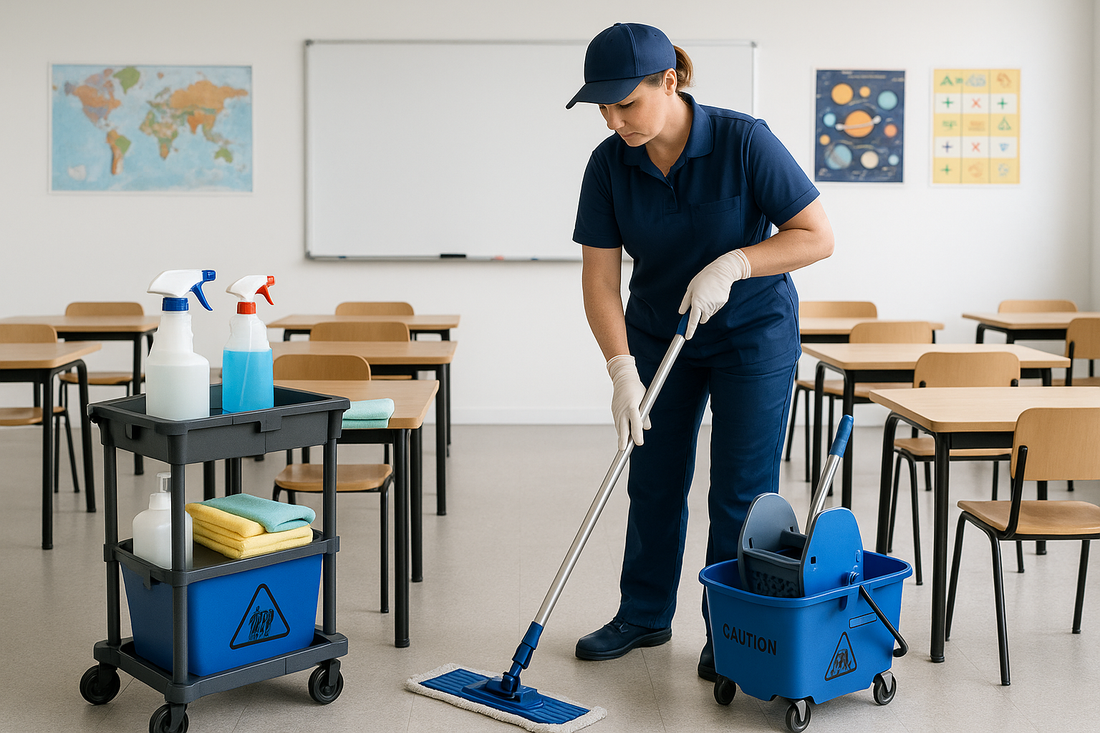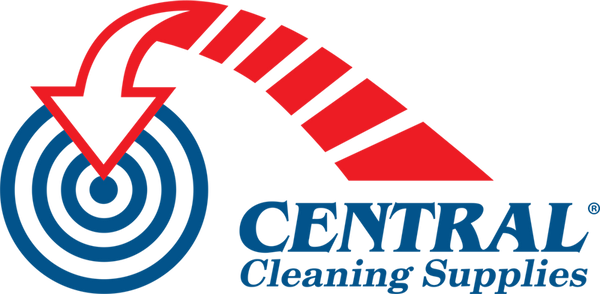
Educational Institution Cleaning Challenges
Share
Educational Excellence Through Superior Cleaning
Transform learning environments with specialised cleaning strategies that protect student health, enhance academic performance, and create inspiring spaces where education thrives. Master the unique challenges of educational institution cleaning with proven professional techniques.
The Critical Importance of Educational Cleaning Excellence
Educational institutions aren't just buildings – they're the foundation of our future. Every classroom, corridor, and common area shapes young minds and influences learning outcomes. Professional cleaning in educational settings goes far beyond aesthetics, directly impacting student health, academic performance, and the overall educational experience.
The stakes are high: Post-COVID awareness has elevated hygiene standards permanently, making professional cleaning an essential component of educational excellence. Your expertise doesn't just clean spaces – it creates environments where learning flourishes.
🏫 Understanding Educational Cleaning Challenges
Educational institutions present unique cleaning challenges that demand specialised knowledge, age-appropriate approaches, and unwavering attention to safety standards. Each environment – from early childhood centers to universities – requires tailored strategies that balance effectiveness with the specific needs of different age groups.
Early Childhood Centers
Specialised toy sanitisation, non-toxic product requirements, lower surface contamination management, and enhanced spill protocols for toilet training and feeding activities.
Primary Schools
Shared learning materials cleaning, art supply residue management, reading corner maintenance, and personal storage area hygiene protocols.
Secondary Schools
Laboratory chemical handling, technology-heavy environment cleaning, personal care product management, and specialised equipment maintenance.
Universities & Colleges
Large-scale facility management, diverse space types, 24/7 operation requirements, and specialised research facility cleaning protocols.
Australian Compliance Framework
Educational cleaning in Australia operates under multiple regulatory frameworks including ACECQA (Australian Children's Education and Care Quality Authority), NHMRC (National Health and Medical Research Council) guidelines, and state-specific education department standards. Understanding these requirements is essential for delivering compliant, effective cleaning services.
🎯 Age-Specific Cleaning Strategies
Different age groups present unique cleaning challenges that require specialised approaches, products, and frequencies. Mastering these distinctions is crucial for delivering effective, safe cleaning services across all educational levels.
Ages 0-5: Early Learning
Focus on toy sanitisation after each use, mouth-safe cleaning products, enhanced floor cleaning for crawling activities, and immediate spill response for feeding and toilet training incidents.
Ages 5-12: Primary Education
Shared material cleaning protocols, art and craft supply residue management, library and reading area maintenance, and personal storage hygiene systems.
Ages 12-18: Secondary Education
Laboratory safety protocols, technology equipment cleaning, locker and personal area maintenance, and specialised sports facility cleaning requirements.
18+ Higher Education
Large-scale facility management, research laboratory protocols, dormitory cleaning standards, and 24/7 operation maintenance systems.
📋 Systematic Cleaning Protocols
Professional educational cleaning requires systematic approaches that ensure consistent results while maintaining safety standards. Follow these proven protocols to deliver exceptional outcomes across all educational environments.
Classroom Foundation Cleaning
Begin with high-touch surface disinfection including door handles, light switches, desks, and chairs. Use age-appropriate, non-toxic products that meet educational safety standards. Focus on shared surfaces that facilitate disease transmission between students and staff.
Technology & Equipment Care
Clean interactive whiteboards, tablets, computers, and charging stations using electronics-safe products. Maintain equipment functionality while ensuring hygiene standards. Pay special attention to shared devices that multiple students use throughout the day.
Floor Care Excellence
Implement appropriate floor care for different surfaces – carpet extraction in reading areas, hard floor maintenance in high-traffic zones, and specialised treatment for sports facility flooring. Consider slip resistance and rapid drying times.
Specialised Area Protocols
Address unique requirements for laboratories, art rooms, libraries, and food service areas. Each space demands specific products, techniques, and safety protocols that balance cleaning effectiveness with specialised equipment protection.
Quality Assurance & Documentation
Implement comprehensive inspection procedures and maintain detailed cleaning logs for compliance and accountability. Regular quality checks ensure consistent standards and identify areas for improvement.
🧪 Safe Chemical Selection for Educational Environments
Critical Chemical Safety Requirements
Domestic products are prohibited in educational settings. Vinegar, baking soda, and household cleaners do not meet the antimicrobial efficacy required for educational environments. Only TGA-approved, commercial-grade products designed for educational use should be employed.
Advanced Cleaning Technology
Modern educational cleaning leverages breakthrough technologies like electrolyzed water systems that achieve 99.999% pathogen elimination using only natural elements. These systems eliminate chemical residues while delivering superior antimicrobial performance, perfect for sensitive educational environments.
🏃♂️ High-Traffic Area Management
Educational institutions experience intense traffic patterns that create unique cleaning challenges. Corridors, cafeterias, libraries, and common areas require specialised approaches that maintain cleanliness during continuous use.
Corridors & Hallways
Manage intense traffic during class changes with slip-resistant floor care, handrail disinfection, and wall protection systems that withstand constant contact.
Cafeterias & Food Areas
Implement food safety compliance cleaning, immediate spill response protocols, and comprehensive waste management systems that prevent pest attraction.
Libraries & Study Areas
Balance resource preservation with hygiene requirements, managing shared computers, study materials, and soft furnishings in quiet learning environments.
Sports & Recreation
Address moisture management, equipment sanitisation, locker room hygiene, and specialised floor care for athletic surfaces and safety requirements.
🛠️ Essential Equipment & Supply Management
Professional-Grade Equipment Portfolio
⚠️ Critical Safety & Compliance Protocols
Essential Safety Guidelines
- Child Safety Awareness: Understanding age-appropriate behaviors and maintaining professional boundaries
- Chemical Storage Security: ACECQA-compliant storage systems preventing child access while ensuring product effectiveness
- Emergency Response Training: Protocols for spills, accidents, and health emergencies during cleaning operations
- Documentation Requirements: Detailed cleaning logs, incident reporting, and compliance verification systems
- Staff Certification: specialised training in pediatric safety and educational environment protocols
- Ventilation Management: Proper air circulation during cleaning to prevent chemical exposure
✅ Quality Assurance & Performance Excellence
Comprehensive Compliance Checklist
Performance Monitoring Excellence
Successful educational cleaning requires measurable standards including task completion efficiency, client satisfaction scores, safety incident tracking, and environmental compliance verification. Digital systems for scheduling, monitoring, and reporting improve operational efficiency and client communication.
Key Success Factors for Educational Cleaning Excellence
- Regulatory Mastery: Comprehensive understanding of NHMRC, ACECQA, and state-specific requirements for educational facility cleaning
- Age-Appropriate Safety: specialised protocols addressing unique safety needs from early childhood through tertiary education
- Chemical Safety Excellence: Proper selection and handling of cleaning chemicals balancing effectiveness with health requirements
- specialised Equipment Investment: Professional-grade systems designed for educational environments including color-coded and child-safe equipment
- Community Integration: Building relationships with administrators, staff, and communities for long-term service partnerships
- Continuous Improvement: Regular training, auditing, and adaptation to evolving standards and client needs
Transform Educational Environments
Educational institution cleaning represents more than a business opportunity – it's a contribution to the health, safety, and success of future generations. Your expertise creates environments where learning thrives, where students feel safe, and where educational excellence becomes possible.
Master these specialised protocols and become an essential partner in Australia's educational success story. Every clean classroom, every safe corridor, every pristine facility contributes to a brighter educational future.

